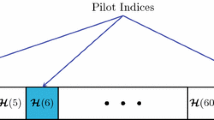Abstract
A novel hybrid channel estimator that gives robust performance with respect to the error in antenna-to-subcarrier assignment (ATSA) for spatially correlated MIMO-OFDM system with per-subcarrier transmit antenna, is proposed. In practice, the antenna selection information is transmitted through a binary symmetric control channel with a crossover probability. Though minimum mean-square error (MMSE) estimator performs well at low signal to noise ratio (SNR), in the presence of antenna selection error it introduces irreducible error at high SNR. In this paper, we have proved that relaxed MMSE estimator overcomes the performance degradation at high SNR, with less computational complexity. The proposed hybrid estimator combines the benefit of MMSE at low SNR and relaxed MMSE estimator at high SNR. Further, an analytical expression for SNR threshold at which the hybrid estimator is to be switched from MMSE to relaxed MMSE is also derived. The simulation results show that the proposed hybrid estimator gives robust performance, irrespective of the ATSA error and power delay profile of the channel.








Similar content being viewed by others
Abbreviations
- \(n_t\) :
-
Number of transmit antennas
- \(n_r\) :
-
Number of receive antennas
- \(L\) :
-
Length of channel
- \(N\) :
-
Number of subcarriers
- \(\mathbf G _l\) :
-
\(n_r\)x\(n_t\) Channel impulse response matrix of the \(l\)th path
- \(\mathbf F _k\) :
-
\(n_r\)x\(n_t\) Channel Frequency Response (CFR) matrix for the \(k\)th subcarrier
- h :
-
CFR after transmit antenna selection
- \(\mathbf h _k\) :
-
CFR after transmit antenna selection with error in \(k\)th subcarrier
- \(\sigma _w^2\) :
-
Noise variance
- S :
-
Block diagonal transmit antenna selection matrix
- Q :
-
MMSE linear transformation matrix
- \(\mathbf R _\mathbf h \) :
-
Autocorrelation of matrix of h
- \(\mathbf D _k\) :
-
Diagonal matrix with eigenvalues of \(\mathbf{R _\mathbf h }_k\) (auto-correlation matrix of \(\mathbf h _k\) )
- \(\mathbf U _k\) :
-
Matrix having eigenvectors of \(\mathbf{R _\mathbf h }_k\) as column vectors
- \(\mathbf Q _R\) :
-
RMMSE(Relaxed MMSE) linear transformation matrix
- \(\text {MSE}_c\) :
-
Average MSE of MMSE estimator with perfect ATSA
- \(\text {MSE}_{k,ATSA}\) :
-
Average MSE of MMSE estimator with ATSA error in \(k\)th subcarrier
- \(\text {MSE}_q\) :
-
Average MSE of MMSE estimator with crossover probability q
- \(\beta \) :
-
Signal to noise ratio per subcarrier
- \(SNR_{TH}\) :
-
SNR threshold
References
Chorti, Arsenia, & Brookes, Mike. (2011). Performance analysis of OFDM and DAB receivers in the presence of spurious tones. Telecommunication System, 46(2), 181–190. doi:10.1007/s11235-010-9282-6.
Le Floch, B., Halbert, R., & Castelain, D. (1989). Digital sound broadcasting to mobile receivers. IEEE Transactions on Consumer Electronics, 35(3), 493–503.
Tang, Zhihua, Wei, Guo, & Zhu, Youtuan. (2009). Weighted sum rate maximization for OFDM-based cognitive radio systems. Telecommunication Systems, 42, 77–84.
Paulraj, Arogyaswami J., Gore, Dhananjay A., Nabar, Rohit U., & Blcskei, Helmut. (2004). An overview of MIMO communications a key to gigabit wireless. Proceedings of the IEEE, 92(2), 198–218.
Cariou, L., & Helard, J. F. (2005). MIMO frequency hopping spread spectrum multi-carrier multiple access: A novel uplink system for B3G cellular networks. Telecommunication Systems, 30(1/2/3), 193–214.
Pollock, Tony S., Abhayapala, Thushara D., & Kennedy, Rodney A. (2003). Introducing space into MIMO capacity calculations. Telecommunication Systems, 24(2–4), 415–436.
Tuan, Hoang D., Kha, Ha H., & Nguyen, Ha H. (2010). Optimized training sequences for spatially correlated MIMO-OFDM. IEEE Transactions on Wireless Communications, 9(9), 2768–2778.
Liu, Xia, Bialkowski, Marek, & Lu, Shiyang (2007). Investigations into training-based MIMO channel estimation for spatial correlated channels. IEEE Antennas and Propagation Society International Symposium, pp. 205–208.
Barhumi, M. M. I., & Leus, G. (2003). Optimal training design for MIMO OFDM systems in mobile wireless channels. IEEE Transactions on Signal Processing, 51(6), 16151624.
Stber, Gordon L., Barry, John R., Mclaughlin, Steve W., & Li, Ye (Geoffrey), Ingram, Mary Ann, Pratt, Thomas G. (2004). Broadband MIMO-OFDM wireless communications. Proceedings of the IEEE, 92(2), 271–294.
Chung, Jaeho, Yun, Yusuk, & Choi, Seungwon. (2011). Experiments on MIMO-OFDM system combined with adaptive beamforming based on IEEE 802.16e WMAN standard. Telecommunication Systems, doi:10.1007/s11235-011-9475-7.
Sanayei, S., & Nosratinia, A. (2004). Antenna selection in MIMO systems. IEEE Communication Magazine, 42(10), 68–73.
Zhang, H., & Nabar, R. U. (2008). Transmit antenna selection in MIMO-OFDM systems: Bulk versus per-tone selection. Proceedings of the IEEE ICC, 43714375.
Coon, Justin P., & Sandell, Magnus. (2011). Performance of transmit antenna selection in spacetime-coded OFDM systems. IEEE Transactions on Vehicular Technology, 60(6), 2824–2828.
Vithanage, Cheran, Denic, Stojan, & Sandell, Magnus. (2011). Robust linear channel estimation methods for per-subcarrier transmit antenna selection. IEEE Transaction on Communications, 59(7), 2018–2028.
Park, Ki-Hong, Ko, Young-Chai, & Alouini, Mohamed-Slim. (2010). Low complexity transmit antenna selection with power balancing in OFDM systems. IEEE Transactions On Wireless Communications, 9(10), 3018–3023.
Sandell, Magnus, & Vithanage, Cheran. (2011). Per-tone transmit antenna selection with phase precoding for OFDM. IEEE Transactions on Communications, 59(6), 1514–1518.
Biguesh, Mehrzad, & Gershman, Alex B. (2006). Training based MIMO channel estimation: A study of estimator tradeoffs and optimal training signals. IEEE Transactions on Signal Processing, 54(3), 884–893.
Author information
Authors and Affiliations
Corresponding author
Appendix
Appendix
Using the following property of trace \(Tr\left( A+B+C\right) =Tr\left( A\right) +Tr\left( B\right) +Tr\left( C\right) \), (10) can be rewritten as
With \(Tr\left( AB\right) =Tr\left( BA\right) \) and \(Tr\left( ABC\right) =Tr\left( CAB\right) =Tr\left( BCA\right) \), (37) becomes
Simplifying (38) results in,
(39) can be rewritten as
as in (12). \(\left( \mathbf I -\mathbf Q \right) =\sigma _w^2 \left( \mathbf{R _\mathbf h }_k+\sigma _w^2\mathbf{I _{Nn}}_r\right) ^{-1}\) in Sect. 3 can be verified by adding Q with it as below.
Rights and permissions
About this article
Cite this article
Rajeswari, K., Sashiganth, M. & Thiruvengadam, S.J. A hybrid channel estimator for MIMO-OFDM system with per-subcarrier transmit antenna selection. Telecommun Syst 58, 81–89 (2015). https://doi.org/10.1007/s11235-014-9894-3
Published:
Issue Date:
DOI: https://doi.org/10.1007/s11235-014-9894-3




